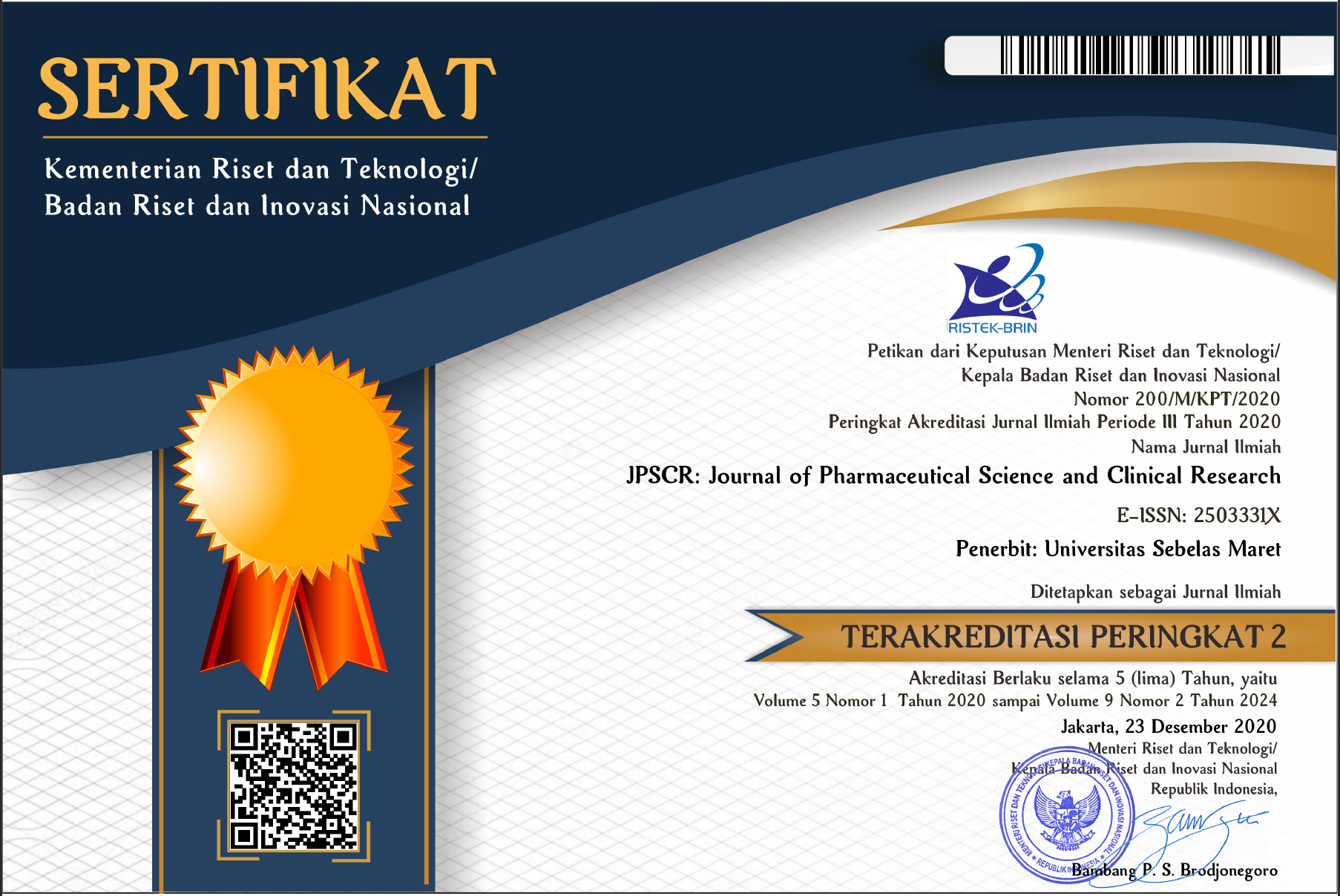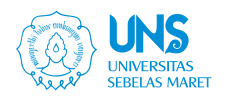Isolasi Fungi Tanah Muara Desa Katialada Gorontalo dan Skrining Aktivitas Antibakteri terhadap Staphylococcus aureus
Abstract
Penyalahgunaan antibiotik sebagai agen terapi pada infeksi dapat memberikan ancaman resistensi antibiotik yang mengakibatkan efektifitas pengobatan menjadi kurang optimal. Untuk mengatasi persoalan tersebut, banyak penelitian dilakukan untuk mencari agen antibakteri baru dari bahan alam seperti fungi tanah sebagai pengujian antibakteri. Penelitian ini bertujuan untuk mengetahui potensi antibakteri dari metabolit sekunder fungi tanah terhadap bakteri Staphylococcus aureus yang ditunjukkan melalui nilai persen penghambatan. Penelitian ini menggunakan metode mikrodilusi untuk mngetahui besaran aktivitas antibakteri pada sampel fungi tanah. Fungi tanah didapatkan dari sampel tanah yang diambil dari desa Katialada, Gorontalo dengan kode lokasi BTG-6 dan dikultur pada media PDA dan diisolasi pada media PDA baru hingga didapatkan 11 isolat tunggal. Skrining awal aktivitas antibakteri dilakukan dengan metode uji antagonis pada 11 isolat dengan hasil enam isolat diantaraya memiliki aktivitas antibakteri terhadap bakteri Staphylococcus aureus. Keenam isolat tersebut akan dilakukan fermentasi dan ekstraksi menggunakan etil asetat untuk mendapatkan ekstrak yang akan digunakan pada pengujian antibakteri menggunakan metode mikrodilusi. Hasil pengujian menunjukkan keenam isolat memiliki aktivitas antibakteri terhadap bakteri uji dan direpresentasikan melalui persen penghambatan pada masing-masing isolat sebesar IS2-BTG6- 1-1 sebesar 34,6 ± 2,4%; IS3-BTG6-1-3-2 sebesar 42,8 ± 3,1%; IS2-BTG6-3-3 sebesar 41,1 ± 4,4%; IS3-BTG6-1-2-1 sebesar 41,8 ± 2,9%; IS3-BTG6-1-2-2 sebesar 47,8 ± 2,6%; IS2-BTG6- 3-3 sebesar 59,2 ± 4,8%.
Keywords
Full Text:
PDFReferences
Balouiri, M., Sadiki, M., & Ibnsouda, S. K. (2016). Methods for in vitro evaluating antimicrobial activity: A review. Journal of Pharmaceutical Analysis, 6(2), 71–79. https://doi.org/10.1016/j.jpha.2015.11.005
Bhattacharyya, P., & Jha, D. K. (2011). Optimization of cultural conditions affecting growth and improved bioactive metabolite production by a subsurface Aspergillus strain. Int. j. Appl. Biol. Pharm, 2(4), 133–143.
Black, W. D. (2020). A comparison of several media types and basic techniques used to assess outdoor airborne fungi in Melbourne, Australia. Plos One, 15(12), e0238901.
CDC. (2015). Staphylococcus aureus in Healthcare Settings. Centers for Disease Control and Prevention. https://www.cdc.gov/staphylococcusaureus/about/?CDC_AAref_Val=https://www.cdc.gov/hai/organisms/staph.html [Accessed 15th June 2022].
CLSI. (2012). Methods for Dilution Antimicrobial Susceptibility Tests for Bacteria That Grow Aerobically; Approved Standard — Ninth Edition (Vol. 32, Issue 2).
Dhanapal, T., Ram Kumar, A., Ramar, R., Balakumar, B., & Kumaresan, S. (2018). IN VITRO ANTI-BACTERIAL ACTIVITY OF THE SOIL FUNGAL METABOLITES. International Research Journal Of Pharmacy, 9(11), 175–181. DOI:10.7897/2230-8407.0911279.
Hackel, M. A., Tsuji, M., Yamano, Y., Echols, R., Karlowsky, J. A., & Sahm, D. F. (2019). Reproducibility of broth microdilution MICs for the novel siderophore cephalosporin, cefiderocol, determined using iron-depleted cation-adjusted Mueller-Hinton broth. Diagnostic Microbiology and Infectious Disease, 94(4), 321–325.
Jiang, M., Wu, Z., Guo, H., Liu, L., & Chen, S. (2020). A Review of Terpenes from Marine-Derived Fungi: 2015–2019. Marine Drugs, 18(6). https://doi.org/10.3390/md18060321
Kapoor, G., Saigal, S., & Elongavan, A. (2017). Action and resistance mechanisms of antibiotics: A guide for clinicians. Journal of Anaesthesiology, Clinical Pharmacology, 33(3), 300.
Keller, N. P. (2019). Fungal secondary metabolism: regulation, function and drug discovery. Nature Reviews Microbiology, 17(3), 167–180.
Kirkwood, Z. I., Millar, B. C., Downey, D. G., & Moore, J. E. (2018). Antimicrobial effect of dimethyl sulfoxide and N, N-Dimethylformamide on Mycobacterium abscessus: Implications for antimicrobial susceptibility testing. International Journal of Mycobacteriology, 7(2), 134–136. https://doi.org/10.4103/ijmy.ijmy_35_18
Loganathachetti, D. S., Poosakkannu, A., & Muthuraman, S. (2017). Fungal community assemblage of different soil compartments in mangrove ecosystem. Scientific Reports, 7(1), 1–9.
Mujeeb, F., Bajpai, P., & Pathak, N. (2014). Phytochemical evaluation, antimicrobial activity, and determination of bioactive components from leaves of Aegle marmelos. BioMed Research International, 2014, 1–11.
Nevalainen, H., Kautto, L., & Te’o, J. (2014). Methods for isolation and cultivation of filamentous fungi. Environmental Microbiology: Methods and Protocols, 3–16.
Parwanto, D., & Wibowo, M. A. (2015). Uji Aktivitas Antioksidan Dan Sitotoksisitas Fraksi Daun Kentutan (Paederia foetida L.). Jurnal Kimia Khatulistiwa, 4(1), 1–6.
Pinheiro, E. A. A., Pina, J. R. S., Paixão, L. K. O., Siqueira, J. E. S., Feitosa, A. O., Carvalho, J. M., Marinho, P. S. B., Marinho, A. M. R., & others. (2018). Chemical constituents and antimicrobial activity of soil fungus Aspergillus sp. FRIZ12. Revista Virtual de Quimica, 10(5), 1438–1445.
Ramar, R., Dhanapal, T., Ram Kumar, A., Balakumar, B., & Kumaresan, S. (2019). Bio-Activity of Secondary Metabolites Extracted From Soil Fungi. International Journal of Scientific Research and Reviews, 8(2), 887–901.
Rasigade, J.-P., & Vandenesch, F. (2014). Staphylococcus aureus: A pathogen with still unresolved issues. Infection, Genetics and Evolution, 21, 510–514. DOI: 10.1016/j.meegid.2013.08.018
Reddy, C. A., Beveridge, T. J., Breznak, J. A., Marzluf, G. A., Schmidt, T. M., & Snyder, L. R. (2014). Introduction to Mycology. In Methods for General and Molecular Microbiology (pp. 925–928). ASM Press.
Shaikh, J., & Patil, M. (2020). Qualitative tests for preliminary phytochemical screening: An overview. Internatinal Journal of Chemical Studies, 8(2), 603–608. https://doi.org/10.22271/chemi.2020.v8.i2i.8834
Swapna, P. K., & Lalch, P. D. (2017). Fungal Biodiversity of a Library and Cellulolytic Activity of Some Fungi. Indian Journal of Pharmaceutical Sciences, 78(6), 849–854.
Thatoi, H., Behera, B. C., & Mishra, R. R. (2013). Ecological role and biotechnological potential of mangrove fungi: a review. Mycology, 4(1), 54–71. https://doi.org/10.1080/21501203.2013.785448
WHO. (2018). Antimicrobial Resistance. https://www.who.int/news-room/fact-sheets/detail/antimicrobial-resistance [Accessed 15th June 2022].
WHO. (2020). The Top 10 Cause Death: Indonesia. World Health Organization. who.int/mortality-and-global-health-estimates/leading-cause-of-death [Accessed 15th June 2022].
Widyawati, P. S., Budianta, T. D. W., Kusuma, F. A., & Wijaya, E. L. (2014). Difference of solvent polarity to phytochemical content and antioxidant activity of Pluchea indicia less leaves extracts. International Journal of Pharmacognosy and Phytochemical Research, 6(4), 850–855.
Refbacks
- There are currently no refbacks.





